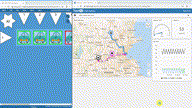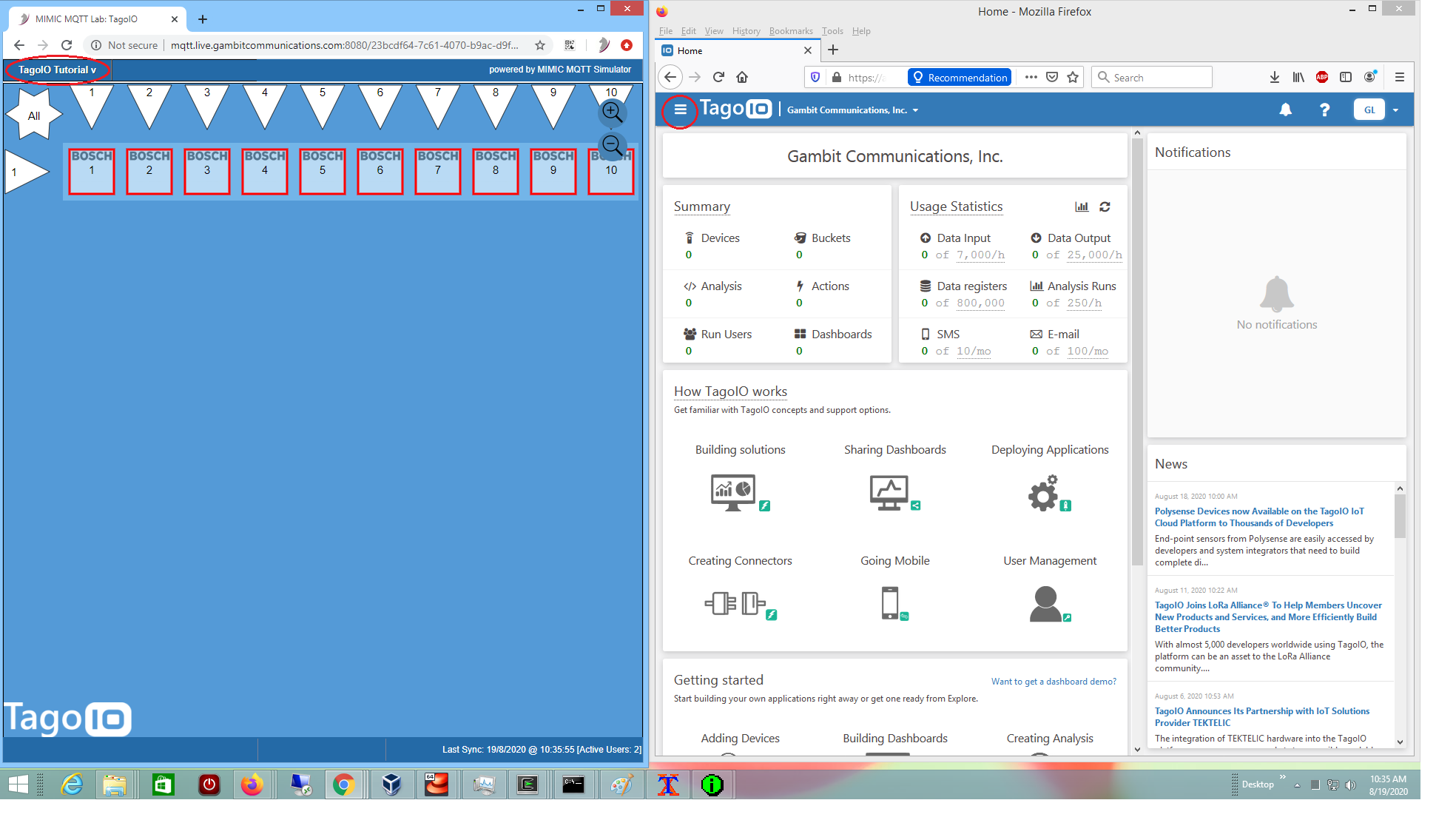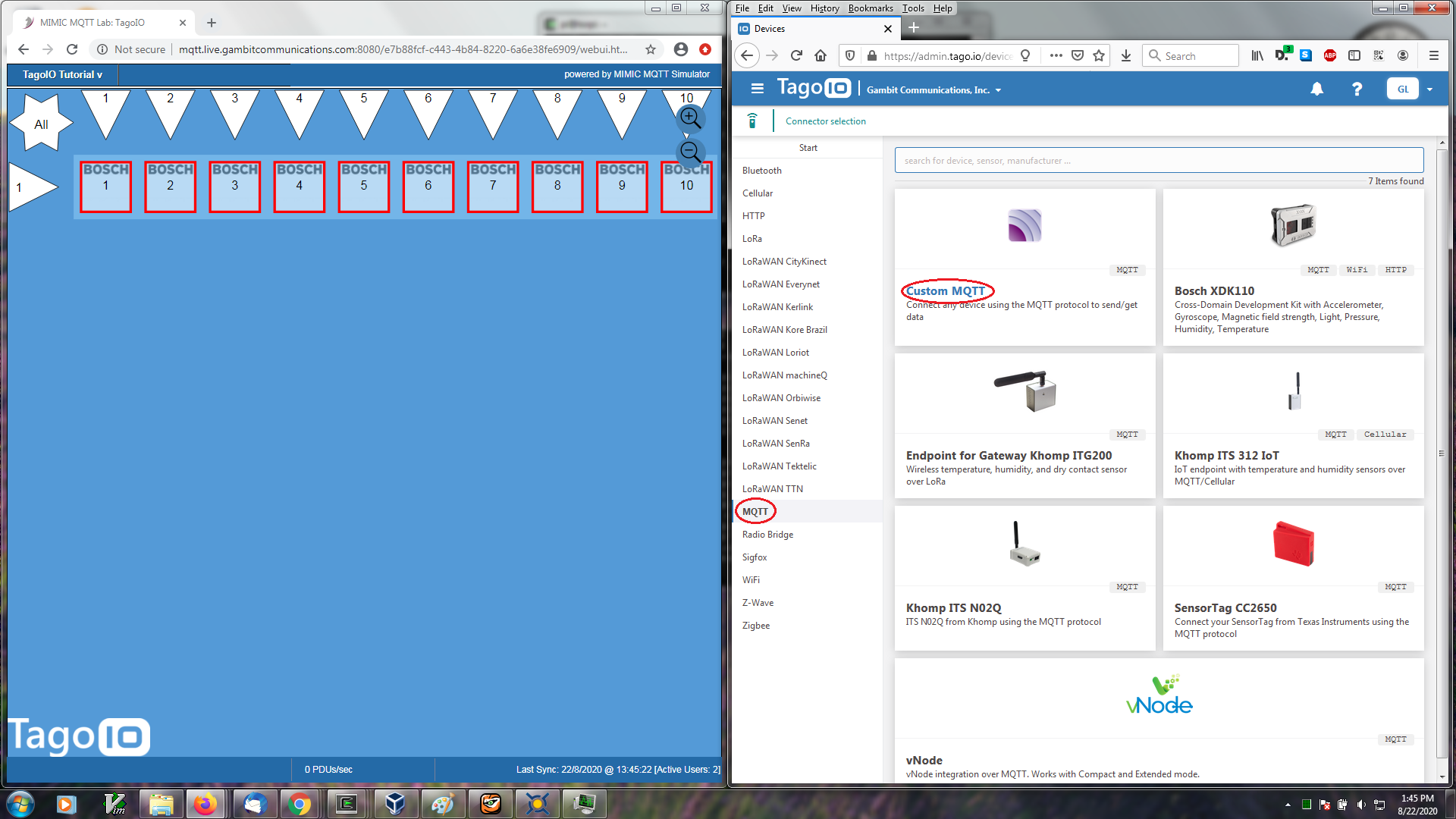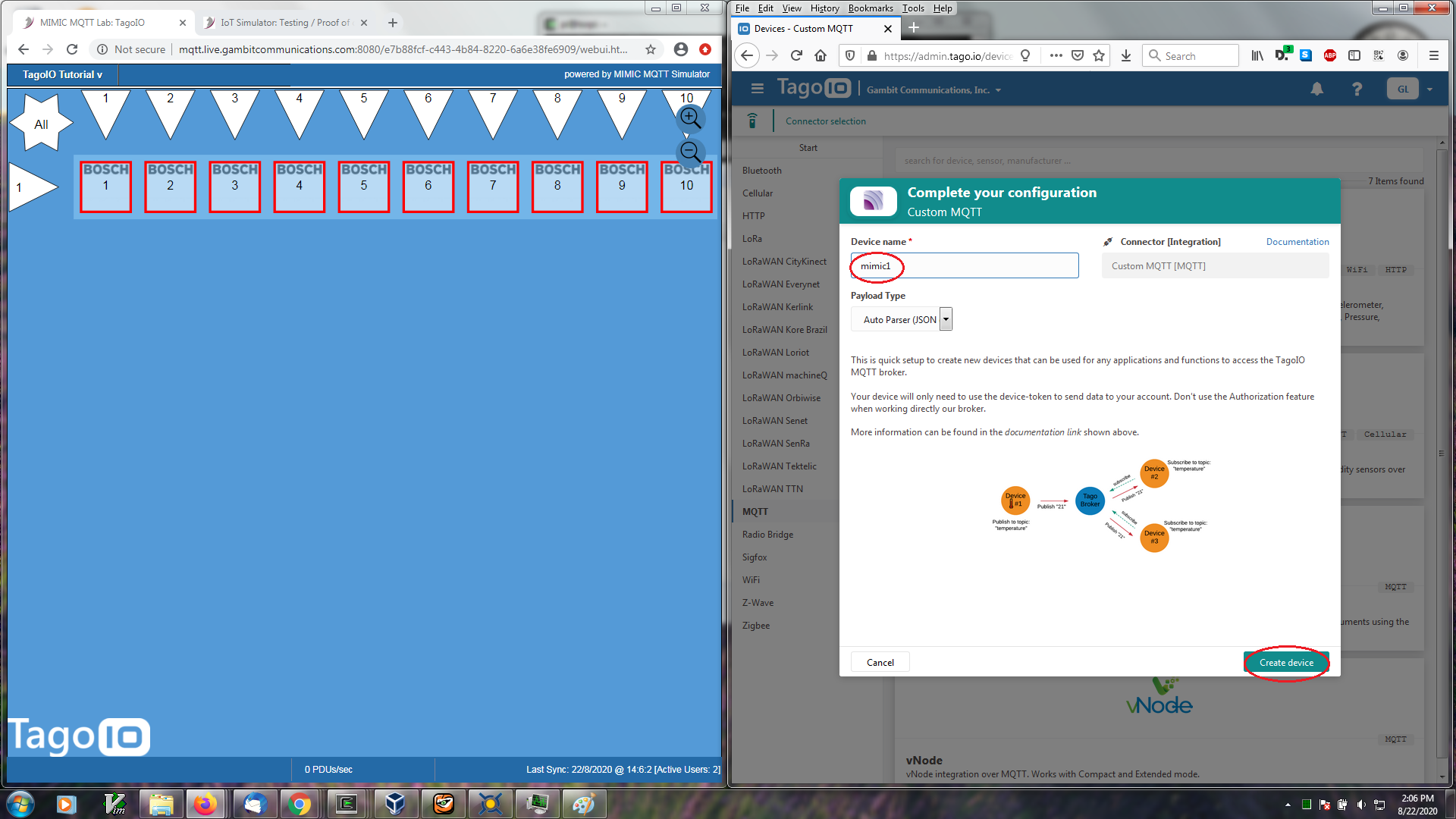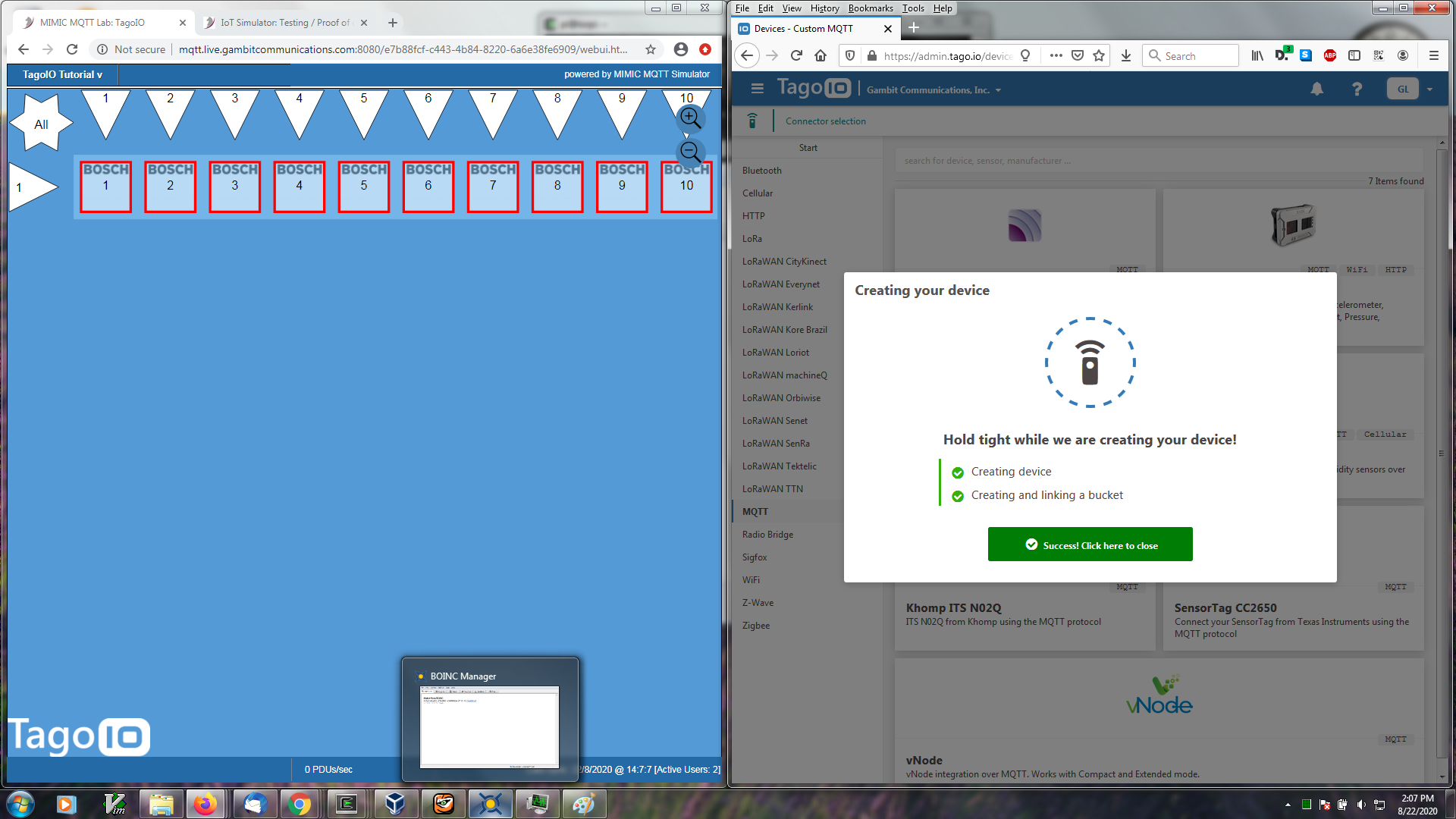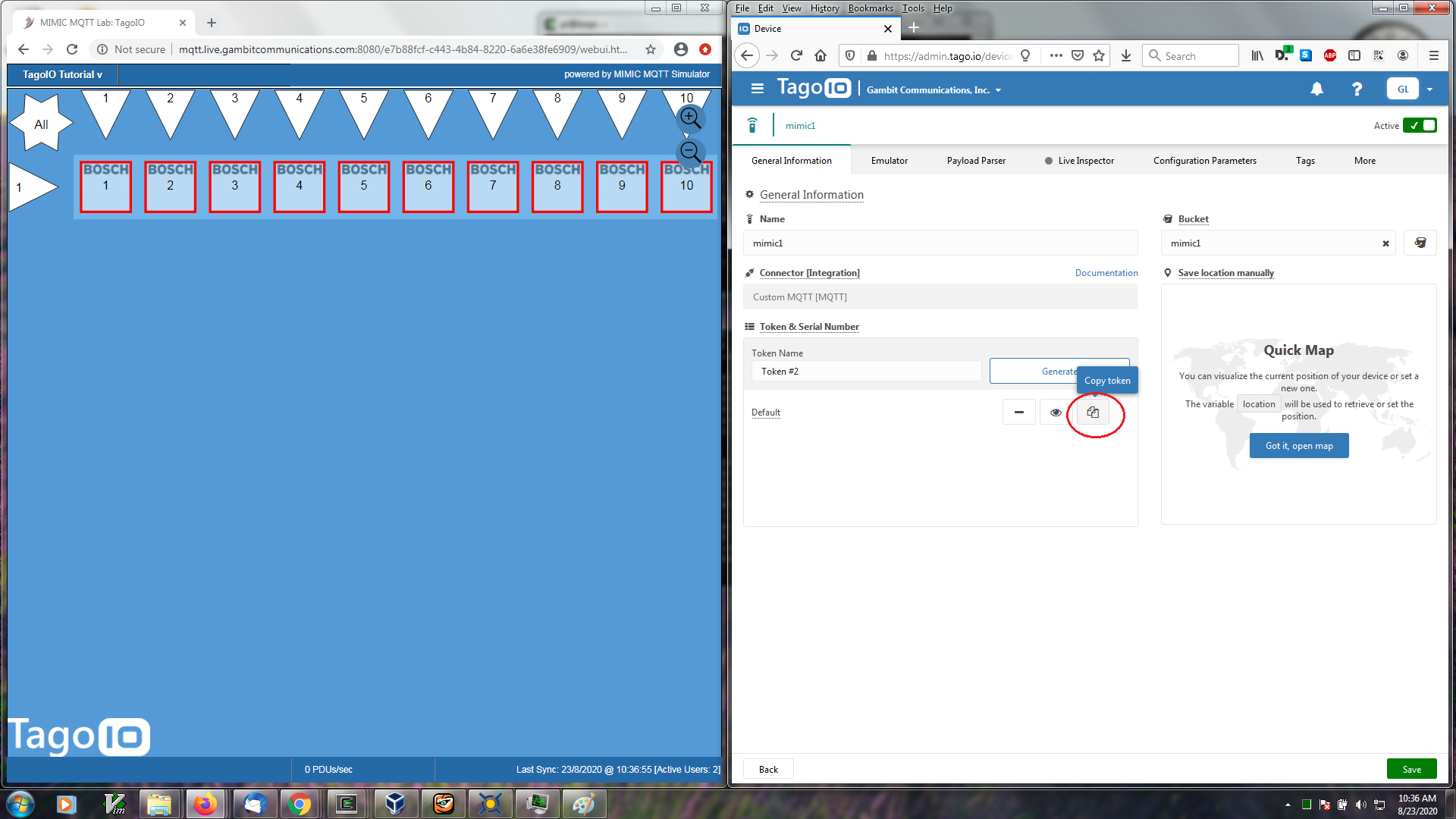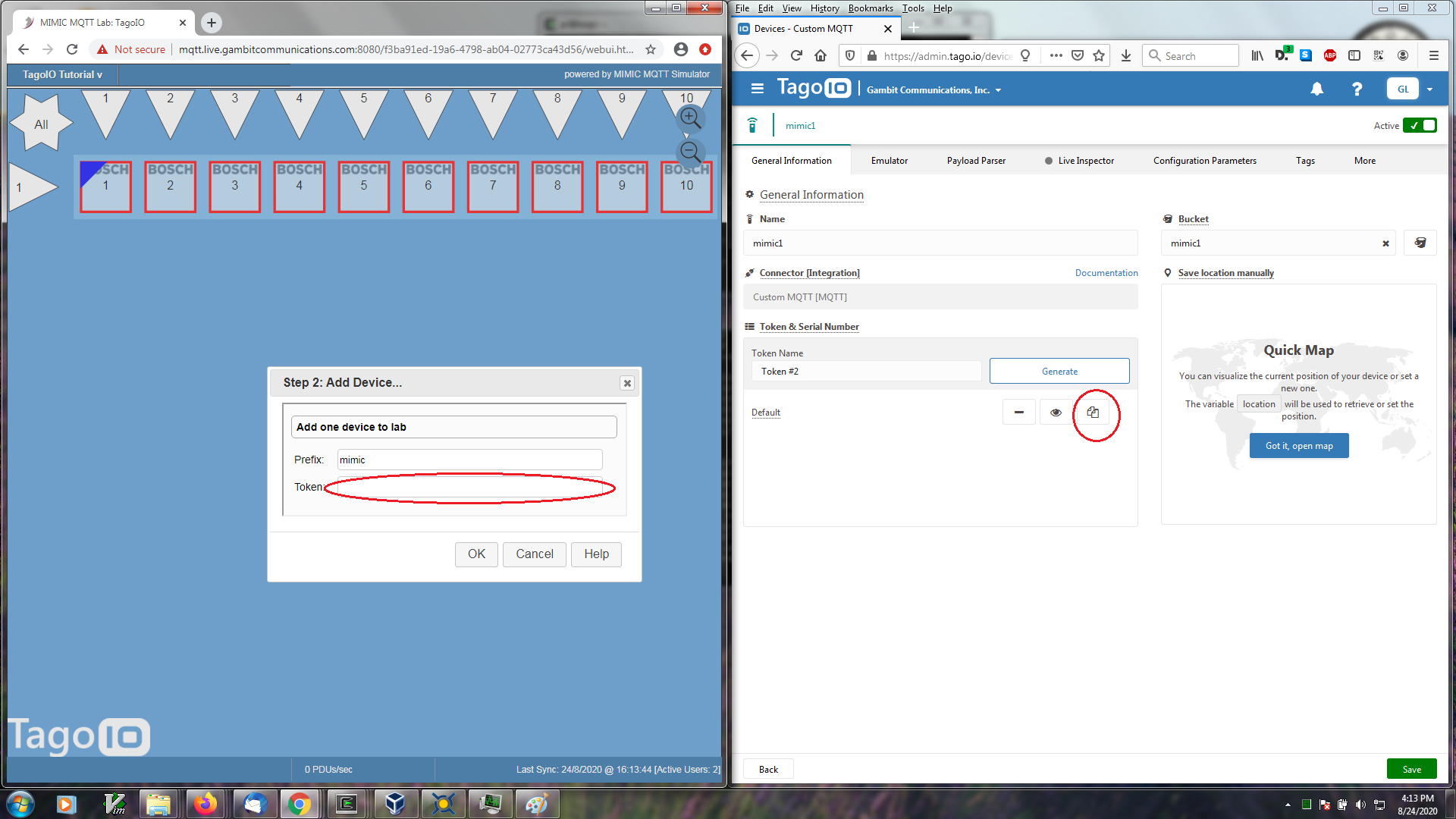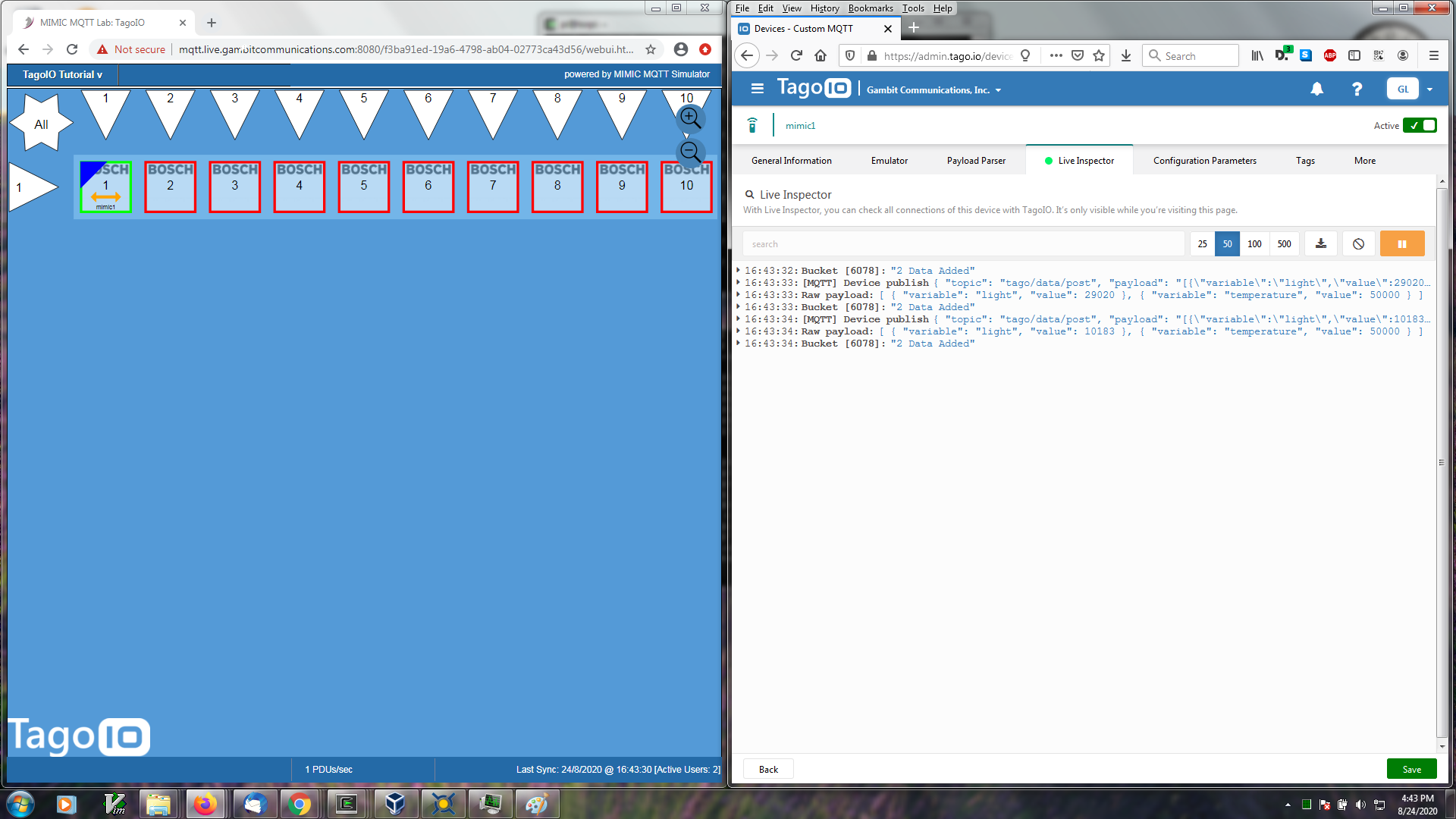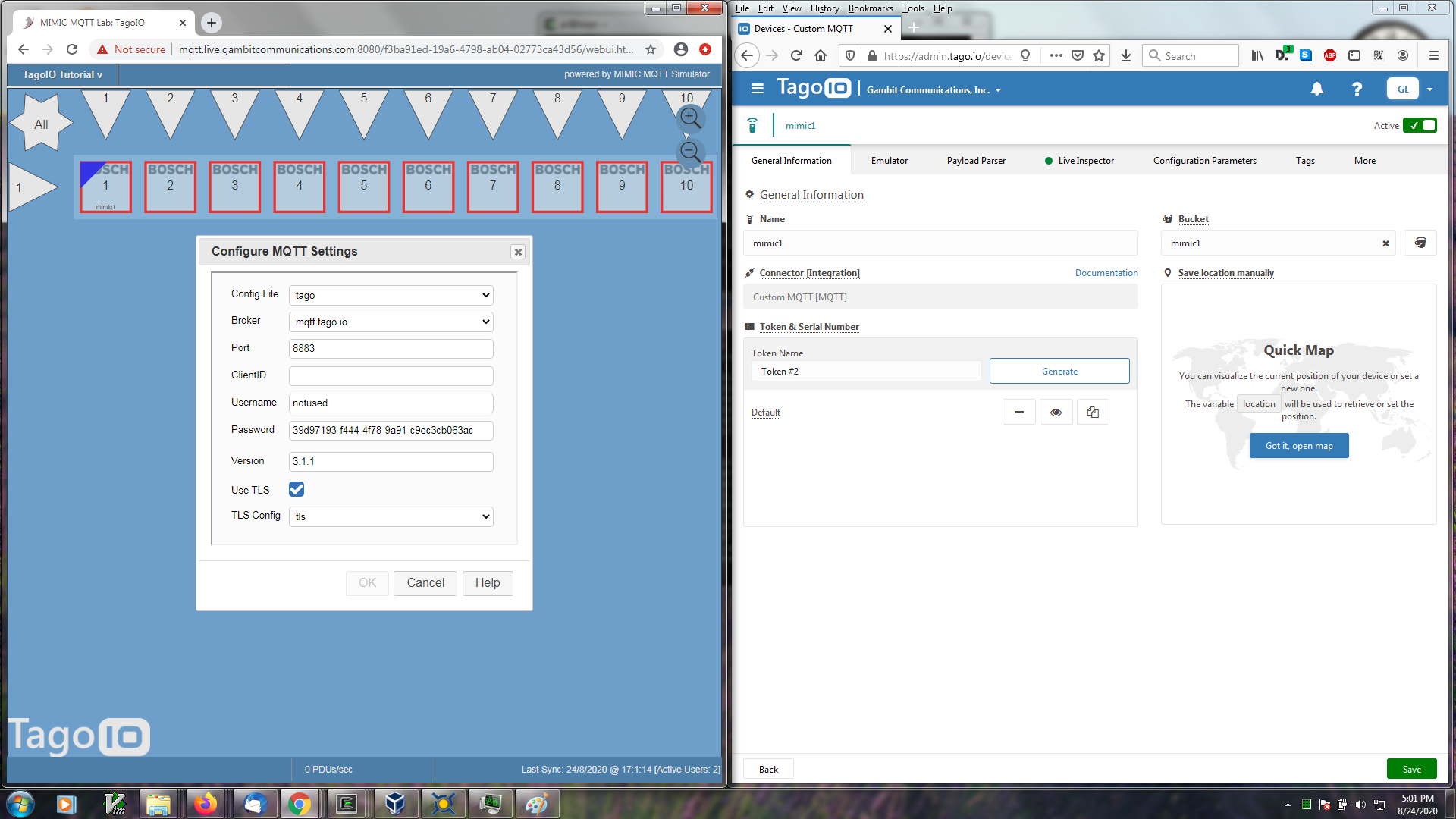MQTTLAB.IOTSIM.IO/tago
Portal for public SaaS MQTT labs based on
MIMIC MQTT Simulator
![]() with
TagoIO
with
TagoIO
![]() as seen on the
partner page
as seen on the
partner page
![]() for
for
-
TagoIO training:
learn in minutes, then go to the TagoIO Learning Center;
-
Rapid Prototyping: Create proof-of-concept applications with dynamic,
customizable, interactive demos for TagoIO applications, like the
demos
below;
- IoT Testing: Test your TagoIO applications for features, scalability and performance / latency.
Free, 24/7, interactive demos
Demo 1 - Asset tracking - vehicle fleet
Check out this 2-minute
Youtube video
Click here
![]() of a
small fleet of vehicles
of a
small fleet of vehicles
![]() updating their device status in TagoIO in
real-time, being graphed in the
TagoIO dashboard.
updating their device status in TagoIO in
real-time, being graphed in the
TagoIO dashboard.
![]()
![]() . Try it out now to change the speed of vehicle 2 with the Demo
menu. Allow a couple of seconds for the speed to show in the TagoIO
dashboard. This shows deterministic control of the telemetry sent to
the TagoIO platform. With simulation you can quickly create the scenarios you
need.
. Try it out now to change the speed of vehicle 2 with the Demo
menu. Allow a couple of seconds for the speed to show in the TagoIO
dashboard. This shows deterministic control of the telemetry sent to
the TagoIO platform. With simulation you can quickly create the scenarios you
need.
Demo 2 - Control System with failure scenario
Check out this 2-minute
Youtube video
Click here![]() of a
control system
of a
control system
![]() tracked by TagoIO in real-time, being graphed in the
TagoIO dashboard.
tracked by TagoIO in real-time, being graphed in the
TagoIO dashboard.
![]() to see
it live 24/7. If nothing is happening because the devices are off, then
change it in real-time with our connected
control system simulation
to see
it live 24/7. If nothing is happening because the devices are off, then
change it in real-time with our connected
control system simulation
![]() . Try it out now to start the equipment with the Demo
menu. Allow a couple of seconds for the temperature of sensor 1 to show
in the TagoIO dashboard. When the temperature goes too high, the actuator
(cooling) is turned on by the TagoIO actions, temperature reported by
the sensor then declines, until actuator is turned off. Once it has
gone through a cycle between high and low temperature, you can create a
failure scenario by "breaking" something with the Demo menu. Even
though the actuator is on, the temperature does not go down. Equipment is
overheating. We need to add actions to detect this!
. Try it out now to start the equipment with the Demo
menu. Allow a couple of seconds for the temperature of sensor 1 to show
in the TagoIO dashboard. When the temperature goes too high, the actuator
(cooling) is turned on by the TagoIO actions, temperature reported by
the sensor then declines, until actuator is turned off. Once it has
gone through a cycle between high and low temperature, you can create a
failure scenario by "breaking" something with the Demo menu. Even
though the actuator is on, the temperature does not go down. Equipment is
overheating. We need to add actions to detect this!
There - you have tested your control system in minutes, not hours or days.
You can try for free (no registration/credit card required) the other MQTT labs , then upgrade to this paid lab if you like it.
TagoIO Get Started Tutorial
Overview
Onboarding an external device to TagoIO for the first time is a task that until now took hours if not days. To overcome this hurdle, we created this TagoIO Getting Started Lab to get started in minutes.
This MIMIC MQTT lab demonstrates integration of
TagoIO
![]() and
MIMIC MQTT Simulator
and
MIMIC MQTT Simulator
![]() to produce an out-of-the-box lab for immediate first-time setup
and use of dynamically controllable
devices
to produce an out-of-the-box lab for immediate first-time setup
and use of dynamically controllable
devices
![]() .
By having a quick, successful example, you will short-circuit integration
of your own devices into TagoIO.
.
By having a quick, successful example, you will short-circuit integration
of your own devices into TagoIO.
Check out this 2-minute
Youtube video
![]() of a small fleet of vehicles updating their device status in TagoIO in
real-time, being graphed in the
TagoIO dashboard. Click here
of a small fleet of vehicles updating their device status in TagoIO in
real-time, being graphed in the
TagoIO dashboard. Click here
![]() to see
it live 24/7. Change it in real-time with our connected
vehicle fleet simulation
to see
it live 24/7. Change it in real-time with our connected
vehicle fleet simulation
![]() . Try it out now to change the speed of vehicle 2 with the Demo
menu. Allow a couple of seconds for the speed to show in the TagoIO
dashboard.
. Try it out now to change the speed of vehicle 2 with the Demo
menu. Allow a couple of seconds for the speed to show in the TagoIO
dashboard.
There are more videos in the
Youtube channel
![]() listed on the right of this page
to show more advanced TagoIO features, such as analysis, events and actions.
listed on the right of this page
to show more advanced TagoIO features, such as analysis, events and actions.
This lab extends the TagoIO
Getting Started
![]() to set up within 15 minutes any number of realistic, third-party,
MQTT-based sensors publishing custom, dynamic telemetry that fits the
TagoIO
MQTT
to set up within 15 minutes any number of realistic, third-party,
MQTT-based sensors publishing custom, dynamic telemetry that fits the
TagoIO
MQTT
![]() guidelines.
There is no limit to the scalability, but we'll setup 1 sensor,
and then you can try the same yourself on any
number in the lab for your requirements (if you need more sensors,
send e-mail to sales@gambitcomm.com).
guidelines.
There is no limit to the scalability, but we'll setup 1 sensor,
and then you can try the same yourself on any
number in the lab for your requirements (if you need more sensors,
send e-mail to sales@gambitcomm.com).
Features
Features of this lab include:
- no prior requirements except for a valid TagoIO account, ie. a
TagoIO login
 ;
;
- no extra setup of hardware, NODE.JS, or cloning of Github source code;
- step-by-step, clear instructions for all tasks;
- 1 realistic sensor (or more) that publishes telemetry via
MQTT
 ;
;
- each sensor is authorized to access your account (and only your account) in TagoIO, just like real devices will have to be;
- dynamic telemetry published over the internet to TagoIO and reflected in the device state;
- real-time, interactive control of the telemetry to reproduce any scenario you want at any point in time;
- investigate all aspects of TagoIO interaction with a third-party device;
- finally, verifiable cleanup of everything we setup automatically.
Tasks
These are the tutorial steps you are going to perform to get going quickly:
Do you have questions? Maybe we answered them in the FAQ below. If not, contact our support team.
The power of MIMIC is not limited to this. If you have a scenario you need simulated, send e-mail to sales@gambitcomm.com.
Step 1: Setup
Objective
Sign up to your own TagoIO account if you have not done it. This takes 5 minutes.
NOTE: NEVER give out your TagoIO account login username and password to anyone you don't trust.
Procedure
We first go to
their home page
![]() and press Get Started to sign up for a TagoIO account.
and press Get Started to sign up for a TagoIO account.
Then review
how Tago works
![]()
To operate your lab, we recommend 2 web browser (Chrome, Firefox, Edge, ...) windows side by side. For example in the left browser window you can have your MIMIC MQTT lab for TagoIO, and in the right your TagoIO cockpit, logged into your TagoIO account, eg. as in Figure 1:
Figure 1 - 2 browser windows side-by-side
When we point to features in either of the windows, they will be highlighted with a red circle. For example, in Figure 1 above we have highlighed the main menu of MIMIC lab and that of the TagoIO cockpit. Check it out by clicking on the Figure 1 picture to open it (make it larger). Then press your browser Back button (left arrow) to get back to this page.
You can maximize either of them when working in one window for a while. When you press README or Help in the MIMIC lab (left browser window), it will open another tab with the help page. Clicking on links in this document to external pages will also open in separate tabs. That way you can switch between the tabs, or lay them out however you wish.
To check it out, click on TagoIO Tutorial, then the top README menu item, and the help page titled Documentation: MQTT Lab for TagoIO appears in a new browser tab. Close the tab by clicking on its x, or switch back to the previous tab.
Results
You signed up to TagoIO and you are ready to use the MIMIC MQTT Lab to add a device, investigate how it connects, and play with it.
Step 2: Add Device(s)
Objective
The left MIMIC MQTT lab browser window shows red icons, one for each simulated device. This is the equivalent of your real-world devices sitting on your lab bench. They are not doing anything.
We need to configure one of the devices to publish telemetry to TagoIO
according to the TagoIO
Devices
![]() rules. This task configures the simulated devices to use the access
parameters (token) that you configured in TagoIO.
rules. This task configures the simulated devices to use the access
parameters (token) that you configured in TagoIO.
Procedure
-
Let's first check on the devices in your TagoIO account (right browser
window).
Your TagoIO cockpit home page shows the number of devices as 0 as shown in Figure 1 above.
Click on the top left main menu (triple bar to the left of the TagoIO logo), then select Devices. There should be no devices, if this is a fresh account. Else, it will show the devices that are registered in this account. There should be no devices from this lab until the next step.
-
Click on Add Device.
Figure 2 - Step 2: TagoIO Add Device dialog
-
Click on the MQTT integration in the left list, then Custom
MQTT.
Figure 3 - Step 2: TagoIO MQTT Integration dialog
-
In the Complete your configuration dialog give the device a name,
for example mimic1. Then press Create device.
Figure 4 - Step 2: TagoIO Complete your Configuration dialog
-
TagoIO will create your device and lets you know when it's done.
Figure 5 - Step 2: TagoIO Creating your device
-
When it's done, the device information appears. You need to copy it's
authentication token to import it into the MIMIC lab. Click on the
Copy token button.
Figure 6 - Step 2: TagoIO Device info
-
In the MIMIC TagoIO lab (left browser window) click on
TagoIO Tutorial -> Step 2: Add Device.... The
Step 2: Add Device dialog appears.
Figure 7 - Step 2: MIMIC Add Device dialog
Type the Prefix for the NAME of the device to be created in your TagoIO account. We recommend to keep mimic, that way you can find it easily later. The first device will be mimic1. Then paste the Token that you copied in the TagoIO cockpit.
Once you click OK, a new Run Script Console tab is opened in the browser with the output of the processing. When it says Task completed, and there are no ERROR messages, your new sensor device is configured in the MIMIC MQTT Lab, ready to connect to your TagoIO account. You can dismiss this tab, or switch back to the lab browser tab titled TagoIO Lab.
If it does not have it already, when you now reload the MIMIC MQTT Lab window, the first icon should have a name underneath its number, eg. the first device will be named mimic1. It is red because it is currently stopped. This is the equivalent of the device sitting on your lab bench in the real world with power switched off.
Results
We configured a new device with name mimic1 and configured it with the authentication parameters necessary to connect to TagoIO;
You are now ready to experiment with this device in the next sections.
Using the lab
To start using the lab, first verify that at least one device with the chosen prefix, eg. mimic1, is showing in your MIMIC MQTT Lab.
Step 3: Start Device(s)
Objective
The devices in your lab are stopped, equivalent to lab equipment sitting on your lab bench and powered off. So they are not doing anything. We need to power up the recently configured device, the one that is labelled mimic1.
Procedure
To start it, select the icon(s) of the device(s) you want to start. Each selected device will have a blue indicator in the upper left. Then click on TagoIO Tutorial -> Step 3: Start Device(s) -> Go!.
The selected icon(s) will turn green, as if you had turned power on.
Just like the equipment on your lab bench, whether it delivers telemetry to TagoIO or not depends on whether you have configured the correct parameters in the MQTT client software.
In this lab, if you added the device as in the section above and there were no errors, then it will publish telemetry once a second. You will know that it works when a orange <--> arrow appears in the icon, indicating activity.
In your TagoIO Iot cockpit mimic1 device page, to see the received telemetry you can select Live Inspector and press the green "play" button as shown in Figure 8:
Figure 8 - Step 3: Device Live Inspector
From the live inspector you see that the telemetry will be updating. In particular, we made it so that the Light value changes frequently at random, like a flickering light. We'll see it in a dashboard in the Step 5: Change Telemetry section below.
Results
The icon of the selected device shows green to indicate that it is started, and telemetry is published to TagoIO. Now you can investigate further how things work, and change telemetry on the fly.
Step 4: Investigate
Objective
Now that it is running, you'll want to see how the lab device and your TagoIO device state are linked. That way you can reproduce this with your real devices.
Procedure
To check the configuration of the device in your TagoIO Device Management page, click on the device name, and then click Info on the left.
To check the configuration of the simulated device in MIMIC, select the device icon in the lab, then click on TagoIO Tutorial -> Step 4: Investigate -> MQTT Configuration...
Figure 9 - Step 4: MQTT Configuration
The important configuration parameters for the device are the
-
Config File - this defines the MIMIC simulation: what MQTT payload
to send where and when. Here we publish once a second the telemetry to
the device topic with a JSON message containing the desired telemetry.
The Light value changes at random for this tutorial. This simulates a very dynamic attribute that changes at every sample.
Finally, the Temperature values can be dynamically controlled to achieve on-demand, consistent, real-time results, eg. in the Step 5: Change Telemetry section below.
-
Broker - your TagoIO broker mqtt.tago.io
-
Port - 8883 for secure MQTT communications
-
ClientID - we use the default MIMIC client ID
-
Username - not used
-
Password - set to your device token
- Use TLS - set to true to use secure MQTT over TLS
These are the configurables you would have to setup in your real-world device to communicate with TagoIO.
NOTE: The OK button is disabled in this lab. More advanced labs allow you to configure anything on the simulated devices.
Results
We verified the necessary configuration for a device to communicate with TagoIO Iot.
Step 5: Change Telemetry
Objective
You are seeing real-time, dynamic telemetry in your digital twin on TagoIO. The Temperature value is static, while the Light value changes at random, like a flickering light. In this task we will interactively change the temperature to some other predictable value. This lets you change the temperature on-demand, eg. a device over-heating. Imagine the effort to do this with a real device.
Procedure
If you have not done so already above, in the MIMIC lab window select the icon(s) of the device(s) you want to manipulate and start it. Each selected device will have a green icon and a blue indicator in the upper left. Then click on TagoIO Tutorial -> Step 5: Change Telemetry....
In the Step 5: Change Telemetry dialog, change the Temperature value to something else, eg. 60000. As soon as you slide the slider to a new value, the new temperature value is published. If you click OK, the value is preserved, if you click Cancel, the value goes back to what it was when you entered the dialog.
In this 2-minute
Youtube video
![]() we create a dashboard and show the temperature and light telemetry
updating in real-time.
we create a dashboard and show the temperature and light telemetry
updating in real-time.
Results
We changed temperature telemetry on the fly, on-demand, predictably. You can use this technique when it comes to testing your application for certain conditions.
Step 6: Stop Device(s)
Objective
Your lab devices are continuously generating telemetry and publishing messages to TagoIO. This task stops them, the equivalent of powering down the real equipment.
Procedure
In the MIMIC lab window select the icon(s) of the device(s) you want to stop. Each selected device will have a blue indicator in the upper left. Then click on TagoIO Tutorial -> Step 6: Stop Device(s).
The icon(s) will turn red, and messages cease to be published.
This is the equivalent of turning power off to your real device.
Results
We stopped the devices to stop publishing messages.
Step 7: Advanced Tasks
These are further optional tasks you can do in your lab:
-
repeatedly do
Step 2: Add Device
, and it will add more things with incrementing instance number upto
the total allowed in your lab. Once you start the lab devices,
you will see independent telemetry for each;
-
create other
dashboards
 to display the telemetry any way you want;
to display the telemetry any way you want;
-
test
analysis,
actions and events
 to act on the telemetry received, as shown in this
2-minute video
to act on the telemetry received, as shown in this
2-minute video
 ;
;
Step 8: Cleanup
Objective
Once a lab is setup, you want to clean it up when you are done, to be certain no left-over devices have access to your account. This procedure makes certain there are no left-overs.
Procedure
The TagoIO Tutorial -> Step 8: Cleanup... lets you cleanup devices setup in the lab. Just select the device(s), then that menu item cleans up any associated resources from the MIMIC MQTT Lab. You need to delete the associated devices from TagoIO.
Once you have deleted a device, you can add one back in with different credentials with the Add step above.
Frequently Asked Questions
- Q: What will this cost me?
A: Besides the fixed cost for the MIMIC MQTT lab, there will be TagoIO costs
 in your TagoIO account that we cannot control, beyond
their free evaluation.
in your TagoIO account that we cannot control, beyond
their free evaluation.
- Q: What exactly does this do to my TagoIO account?
A: If you run the Step 2 - Add dialog with correct TagoIO authentication parameters, and start the device, it will setup exactly 1 device instance in your TagoIO account. Any subsequent devices connecting to TagoIO from this lab will be added as well.
Since we NEVER know your account authentication parameters, we cannot do anything else to your account.
- Q: What about security / privacy?
A: The lab will be able to access your account during the session because device authentication parameters (tokens) are stored in the lab configuration. You can change tokens for the devices in your TagoIO device dialog. Then you can verify that the devices can no longer talk to your account. This is verifiable cleanup, ie. you have proven that the outside device cannot access any more.
- Q: Where can I get help?
A: For the MIMIC lab select the README menu item, or press the Help button in any dialog. If you still need help, send e-mail to support@gambitcomm.com.
For Tago, see their Help Center
 or
online community
or
online community
 .
.
- Q: What next?
A: This lab gives you a small successful step in connecting a few third-party sensors publishing real-time, dynamic, predictable, controllable telemetry to TagoIO in a matter of minutes. The next steps are up to you:
- You can build on what you learned to connect your own devices to
TagoIO;
-
Explore our other free resources / videos to learn about solutions to
common problems you will encounter in IoT development;
-
You can
rent an advanced lab
anytime you need to test different aspects of your
application, or lease a longer-term
MIMIC MQTT Simulator
 with more features;
with more features;
- You can scale the deployment to as many devices as you need to test, demo, train your IoT Application.
- You can build on what you learned to connect your own devices to
TagoIO;

